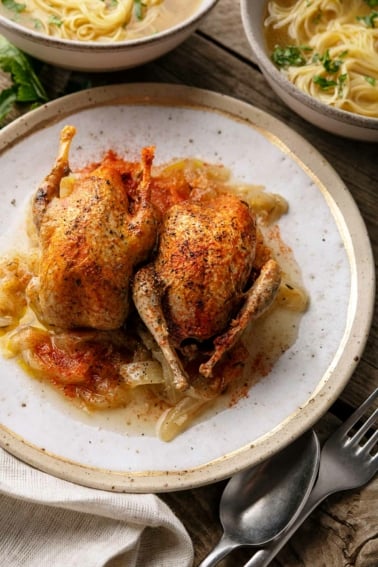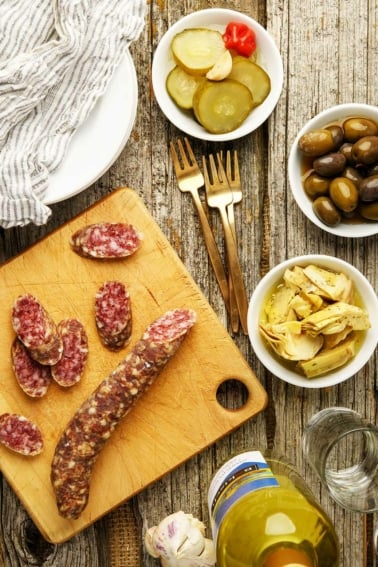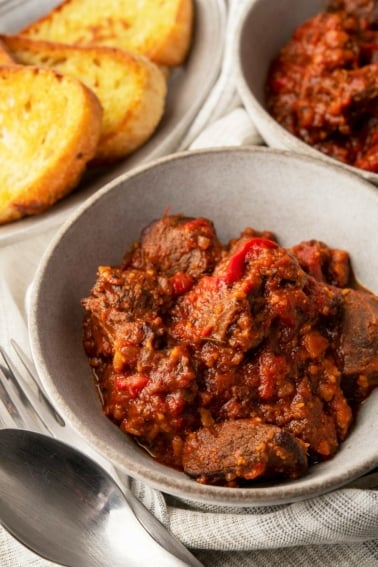As an Amazon Associate I earn from qualifying purchases.
This is my version of the famous Portuguese kale soup with linguica, caldo verde — arguably the national dish of Portugal.

Smoked linguica sausage. Tender, creamy white beans. Portuguese kale, sliced so thin it’s like a spider web in your bowl. This is what you do with your homemade linguica, especially if you happen to have wild boar linguica, as I did.
There are a lot of versions of the famous Portuguese kale soup with linguica, and this one is inspired by a recipe from the Azores I found in my friend David Leite’s cookbook The New Portuguese Table. It’s a peasant stew, really. Heavy on beans (or potatoes, in most versions) and heavy on the kale, most versions skimp on the linguica and don’t use stock or broth — water is all.
I like that. I like the clarity of flavor you get with water, and with a stew that doesn’t have 50 ingredients in it. Sometimes, simple is better.
Most of you don’t have access to Portuguese kale, which is not like other kale. You can buy seeds for it online and grow it yourself, or use it’s closest, easily available cousin, collard greens. Chard, lacinato kale and turnip greens would also work.
Ideally the green you use isn’t too crinkly, because you want to julienne the leaves into very thin strands, and this is more difficult with bumpy, crinkly greens like regular kale.
Most recipes for Portuguese kale soup with linguica use potatoes instead of white beans, so feel free to use 1 to 2 pounds of white or yellow potatoes instead. As for the sausage, obviously you want Portuguese linguica. But andouille, Texas hot links, spicy Italian sausage or something else similar will all work.
Caldo verde comes together pretty fast, all things considered. If you use canned white beans, you can make it in 45 minutes — and this is easy enough to make on a weeknight.
Portuguese Linguica Stew
Ingredients
- 2 tablespoons olive oil
- 1 medium yellow onion, chopped
- 4 cloves of garlic, chopped
- 1/2 cup white wine
- 2 bay leaves
- 1 teaspoon red pepper flakes
- 1 pound linguica sausage, cut into large pieces
- 6 cups water
- Salt
- 1/2 pound collard greens, stems removed and sliced very thin
- 1 15- ounce can cannellini beans or other white beans
- Ground black pepper
Instructions
- Rinse the beans out thoroughly and set aside.
- Heat the olive oil in a large pot over medium-high heat and sauté the onions, stirring occasionally, until they just begin to brown, about 5 minutes. Add the garlic and cook for another minute.
- Add the white wine and cook this down by half.
- Add the collard greens, bay leaves, red pepper flakes and water. Stir well and bring to a simmer. Add salt to taste. Cover, turn the heat to medium-low and simmer gently for 30 minutes.
- Uncover the pot and add the sausage and beans. Cook for another 10 minutes. Serve with ground black pepper.
Notes
Nutrition
Nutrition information is automatically calculated, so should only be used as an approximation.






I grew up on Cape Cod, surrounded by many Azoreans (including my eldest’s great-grandmother, who arrived in New Bedford at the age of 15, and lived past 100), and we called this kale soup, and made it with common curly kale, kidney or red beans, *and* potatoes. There is no substitute for linguica in this dish. I live in Tucson, now, where it is hard to come by. Gonna try making some linguica first, and then maybe some kale soup.
All types and combinations of Portuguese-style stews combining sausages, bacon, ham, or other cured pork meats with vegetables and beans (red, white, large or small, preferably fresh, or dried and soaked overnight – these are always better than canned beans) freeze perfectly and are very good after thawing, as do most “day-after” dishes. You can also try stewing the same type of meats with broad beans (fresh or frozen), using lettuce in the stew or as a side salad (no other extra vegetables in this case). The broad bean stew is also much quicker to cook. Along wit the onion-garlic-parsley base of all these stews, the broad bean combination is particularly good when fresh coriander is liberally added to the base, and generously sprinkled, chopped, on top of the stew.
Did this tonight with what I had: potatoes instead of beans, kielbasa instead of linguica, white vermouth instead of white wine, and a shit-ton of kale (the garden went crazy because of an early summer in Seattle) instead of collard greens.
Verdict: Good, but needed more spice to balance out the heartier greens; will add red pepper flakes as I reheat the other portions. Will also update if the kale does not hold up in the fridge (concerned that it will not keep as well, flavor-wise).
I have to thank you for the efforts you have put in
penning this site. I’m hoping to see the same high-grade content by you in the future as well. In fact, your creative writing abilities has encouraged me to get my very own website now 😉
Made this with chard from the back yard and asparagus. Added Piri Piri sauce after serving which made it excellent.
A belated thanks for the shout-out, Hank. Your version looks tops, even though I do opt these days for non-meat meals. Yeah, sometimes I miss sausage. ; )
Best wishes on the launch of your new book.
On the same wavelength! My over-wintered collards are bolting and it’s time to finish them off. Picked up some Linguica and a ham hock, using potatoes instead of beans, and I’ll be using some ramp whites instead of garlic.
Congrats on the NYT mention today… Sifton was taking a page from your book about unusual birds. Great soup… love linguica.
That looks great. It also looks like a traditional Portuguese bean soup. The Portuguese bean soup in Hawaii is like this but with some tomato base and we use kidney beans. Being Portuguese, I’m shocked to see a blog posting about mainland Portuguese food seen as it’s not common outside of the Northeast US.
And that Linguica looks awesome. Going to have to make that soon.